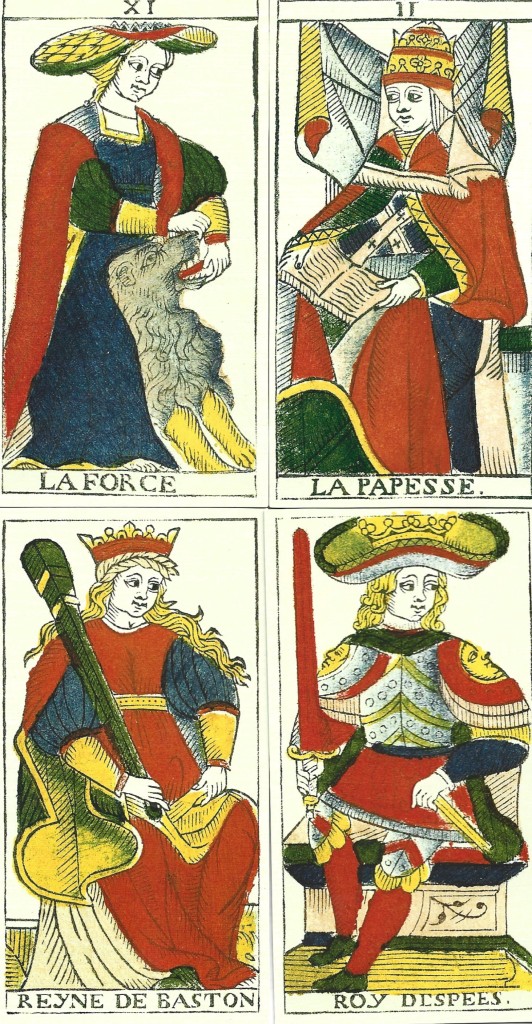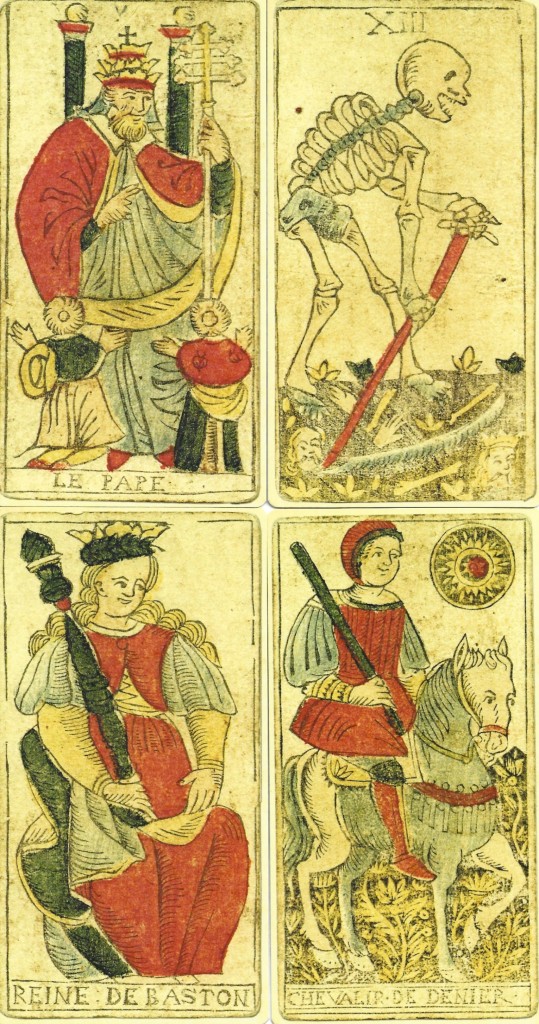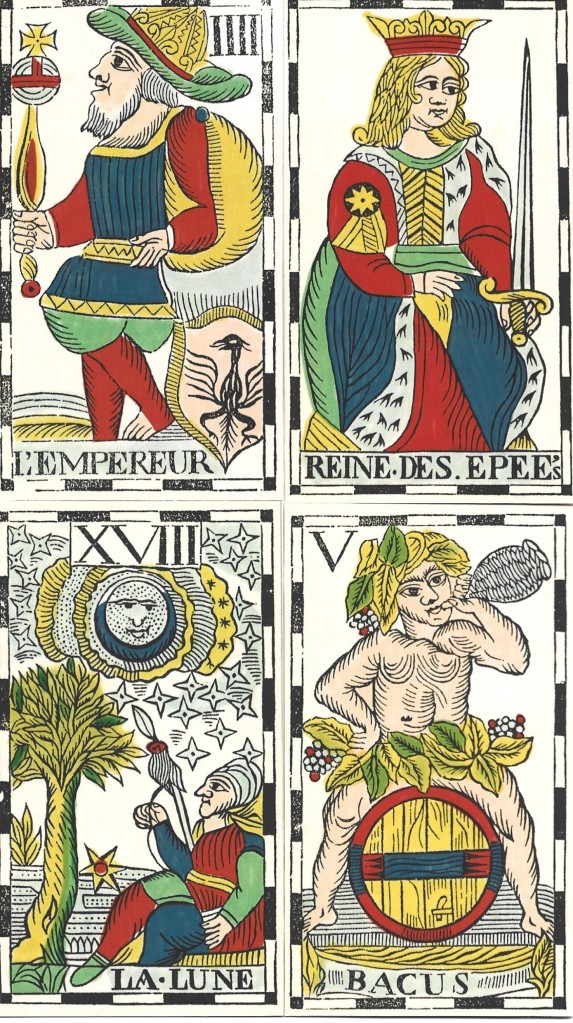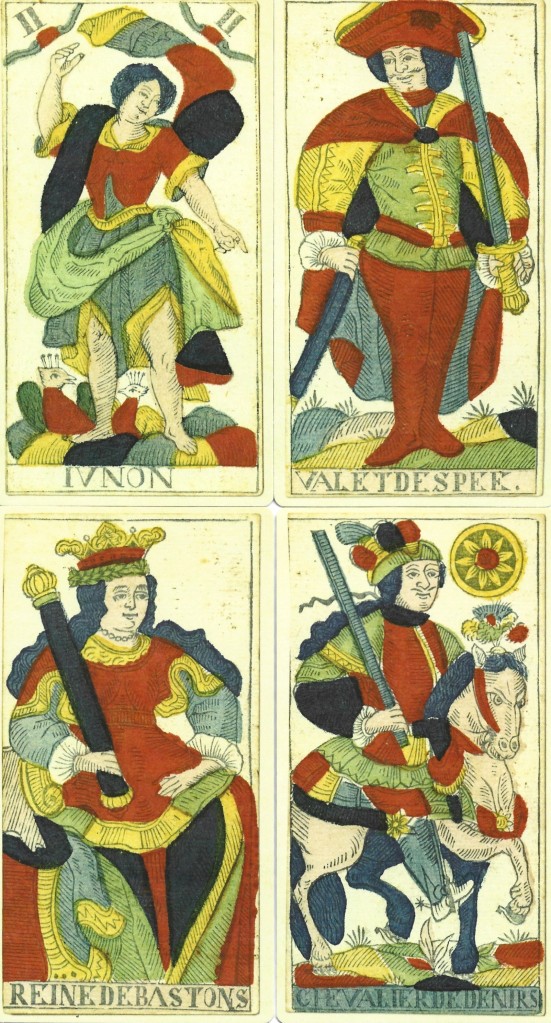The Happiest Tarot Decks
I want start 2024 by showing off the happiest tarot decks in my collection. Let’s face it, some of the people in our pre-20th century decks can be rather grumpy, if not downright mean looking. I must have at least 100 facsimiles of historic decks (I haven’t actually counted them), but I could only find a handful of decks where the figures had consistently pleasant faces. The characters in the decks discussed below look friendly and optimistic, and seem to actually enjoy life. I wouldn’t hesitate to start up a conversation with any of them.
If you have a historic facsimile with happy faces, please share it in the comment section below.
My five choices are all 18th-century decks, from five different countries, made by four contemporary card makers. I’ve listed them in the order they were originally published.
Pierre Madenié Tarot, Dijon, France, 1709
The faces in this deck are consistently friendly and approachable. They seem to be slightly amused, as if nothing could really bother them or knock them off balance.
This is the only traditional French Tarot de Marseille in the list, and is the first deck I acquired from Yves Reynaud (I have them all). I’ve been reading with it for years, so we have a special bond.
Hes Tarot, Augsburg, Germany, c. 1750
It’s easy to imagine enjoying an evening of cards and beer with these easily amused folks. The Pope looks like he’s very pleased with the joke he just told. His acolytes are in stitches, shrieking with laughter. It seems the Grim Reaper overheard the joke. Even the severed heads at the bottom of the card seem amused.
This is a standard French Tarot de Marseille, with French titles, but with its own unique personality. The deck comes with a booklet giving the history of tarot in Germany.
Vandenborre Tarot, Brussels, Belgium, 1762
The gnome-like Emperor seems to be enjoying a joke. You don’t often see a pleasant Queen of Swords. Here she has the friendly, approachable face of many figures in this deck. The old crone on the Moon card seems like a wise and kind grandmother. Then there’s Bacus, the ultimate party animal, replacing the Pope.
Tarot de Besançon Miller, Salzburg, Austria, 1780
Like the characters in the German Hes Tarot, these jolly, corpulent folks look like they’d be great companions around a card table. The Page of Swords is often a sinister character, but here he seems on the point of bursting out laughing at something he’s just seen. This is a Besançon style deck with Jupiter and Juno replacing the Pope and Papesse.
The deck comes with the same booklet as the Hes Tarot, giving a detailed history of tarot in German-speaking countries. In addition, we learn that Mozart probably played cards with this deck while he was living at home in Salzburg. In the summer of 1780, he wrote notations in the margins of his sister’s diary, making sarcastic comments in a mash-up of several languages, then listing how he amused himself that day. Most days he attended mass, took a walk, called on people or received visitors, and ended the day playing Tarot. Since Miller was the only card maker registered in Salzburg at the time, it’s quite likely Mozart used this deck.
Swiss Marseille Tarot, 2022
This deck is a modern reconstruction based on various Swiss decks, including Claude Burdel c. 1751, François Gassman c. 1873, and several incomplete decks in Swiss museums. Most figures have the friendly faces and clear eyes of the cards shown here.
The hand-painted cards shimmer with life thanks to the subtle gradations of intense color.
Illustrations
Top photo: Sun cards from the Hes, Swiss, and Miller decks referenced below.
Pierre Madenié Tarot, Dijon, France, 1709. Collection of the Swiss National Museum of Zurich. Produced by Yves Reynaud, 2013.
Tarot of Marseille Heritage – Pierre Madenié, Dijon 1709 (tarot-de-marseille-heritage.com)
A review of the Madenié deck from 2013 when it first appeared. There have been two more editions since then: https://tarot-heritage.com/2013/05/11/the-pierre-madenie-1709-tarot-de-marseille-facsimile-deck/#more-942
Tarot de Marseille Johann Christoph Hes, Augsburg, Germany, c. 1750. Collection of the British Museum. Produced by Giordano Berti, 2018.
https://rinascimentoitalianartenglish.wordpress.com/marseille-tarot-of-hes-1750/
A review of the Hes deck: https://tarot-heritage.com/2018/12/17/tarot-hes-1750/#more-1752
Tarot Flamand Vandenborre, Brussels, Belgium, 1762. Produced by Pablo Robledo, 2018.
Trabajos :: Pablorobledotarot (webnode.page)
A review of the Vandenborre deck: https://tarot-heritage.com/2018/07/26/the-vandenborre-deck-restored-by-pablo-robledo/
Tarot de Besançon Josef Rauch Miller, Salzburg, Austria, 1780. Collection of the British Museum. Produced by Giordano Berti, 2018.
https://rinascimentoitalianartenglish.wordpress.com/catalog/
A review of the Miller deck: https://tarot-heritage.com/2019/03/06/tarocchi-di-besancon-1780/
Swiss Marseille Tarot, produced by Irene Torres, Naipes Artesanos, 2022.
https://naipesartesanos.blogspot.com/







